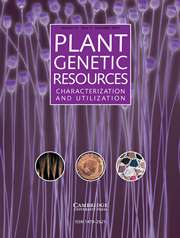Introduction
Germplasm resources are the foundation for improving crop varieties and a strategic asset for global food security. They also drive advancements in plant breeding, agricultural biotechnology and the production of essential agricultural goods (Wang Reference Wang2002; Li et al. Reference Li, Li, Yang, Zhang, Zhang, Qiu and Wang2015). Enriching crop germplasm diversity prevents the extinction of high-potential varieties and provides essential genetic resources to support the development of the plant breeding-related industry. Recently, environmental changes, resource overexploitation and shifts in crop production, and land use have caused the rapid disappearance of many local crop varieties (Liu et al. Reference Liu, Deng, Li, Yang, Yang, Wang and Yu2017). For example, three wild rice species are now classified under China’s second-level endangered plant protection catalog (Fan et al. Reference Fan, Liu, Yun, Tang, Zhou, Xiao, Zheng and Yang2023). Many governments worldwide, such as China, designate germplasm resource protection as a top priority, emphasizing the critical role of germplasm surveys as the cornerstone of seed industry revitalization and highlighting the importance of investigating, collecting and protecting crop germplasm resources (Chen et al. Reference Chen, Li, Liu, Liu and Wan2018; Zeng et al. Reference Zeng, Xie, Cheng, Jiang, Zhou and Xie2019; Li and Yang Reference Li and Yang2022; Lei et al. Reference Lei, Ye, Tan, Zhou and Qin2023).
China conducted two nationwide surveys and collection campaigns of food crop germplasm resources in 1956 and 1981, respectively. These efforts laid a solid foundation for the conservation and utilization of germplasm resources in China. The third nationwide survey and collection campaign of crop germplasm resources was launched in July 2015 and fully completed between 2021 and 2023. This campaign covered 2323 agricultural counties (cities and districts) across China, aiming to comprehensively assess the national status of crop germplasm resources, rescue and collect endangered and rare germplasm, and provide a robust foundation for agricultural breeding innovation, ecological civilization construction and sustainable agricultural development.
Hainan Province, situated at China’s southernmost tip, lies between 108°37′ to 111°03′ east longitude and 18°10′ to 20°10′ north latitude. Positioned on the northern edge of the tropics, Hainan experiences a tropical monsoon climate, earning it the nickname ‘Natural Greenhouse’. The annual average temperature varies between 22.5 and 25.6°C, with the lowest in central Qiongzhong county and the highest in Sanya city in the south. The accumulated growing degree days (temperatures ≥10°C) reach 8200°C. Even in January, the coldest month, temperatures remain between 17°C and 24°C. Additionally, the province receives abundant sunlight, with 1750 to 2650 annual sunshine hours and a light exposure rate of 50–60%. Hainan also experiences abundant rainfall, with annual precipitation ranging from 1000 to 2600 mm. The rainy season, spanning May to October, contributes 70–90% of the annual precipitation, totalling approximately 1500 mm. The dry season, lasting from November to April, provides only 10–30% of the annual rainfall. The soils in the study area are sandy loam with low organic matter content, thus qualifying them as poor soils (Zhang et al. Reference Zhang, Zhang, Gong and Wan-gang2005). In line with this, the main food crops include rice, wheat, maize and soybean. In this study, food crops refer to cultivated varieties, traditional landraces and wild relatives. However, due to the favourable light, temperature and water availability, the area also supports a diverse range of other agricultural and biological resources, such as fruit trees and vegetables, characterized by their strong adaptability, drought resistance and the ability to thrive in poor soils (Zheng and Gao Reference Zheng and Gao2016; Zheng et al. Reference Zheng, Gao, Li and Liu2016).
Previous surveys of food crop germplasm resources in Hainan Province were conducted in 1951, 1981 and the 1990s. These efforts documented the distribution and characteristics of local germplasm resources, providing a valuable historical baseline (Wang et al. Reference Wang, Chen, Huang and Cai1992). Over the next two decades, these resources underwent significant changes. In 2015, China’s Ministry of Agriculture launched the Third National Crop Germplasm Resources Survey and Collection Campaign. As part of this initiative, the Institute of Food Crops (IFC) of the Hainan Academy of Agricultural Sciences (HNAAS), acting as the Hainan survey team, conducted extensive investigations and collections across the province. Between 2017 and 2021, the team focused on assessing the current distribution and cultivation status of genetic resources, prioritizing the collection and conservation of ancient landraces and endangered germplasm (Ministry of Agriculture of the PRC, National Development and Reform Commission, Ministry of Science and Technology of the PRC, 2015). Field investigations and resource collection were carried out in 24 cities, counties and districts, including Haikou, Sanya and Danzhou. These efforts provided valuable insights into the genetic diversity of Hainan’s food crops. Rice has historically been the dominant food crop in Hainan Province, consistently accounting for over 30% of the total cultivated area since 1951. Its significance lies not only in its role as a staple food but also in its cultural importance and adaptability to Hainan’s diverse ecological conditions. This study emphasizes rice to highlight its central role in Hainan’s agricultural landscape and its potential for genetic improvement.
Materials and methods
Survey tools
In the process of germplasm resource collection, we used a variety of tools to ensure the accurate documentation and secure handling of specimens. Seed bags, mesh bags and plastic bags were used for the safe storage. A GPS device, such as the GPS Tool Kit mobile app, was employed to record precise geographic coordinates of collection sites, enabling accurate tracking and mapping of native habitats. Notebooks and pencils (or marker pens) were used by researchers to take detailed field notes, such as environmental conditions and species-specific observations. Tags were used to label specimens and maintain proper identification during storage and transport. Scissors and knife were used to facilitate the clean cutting of plant materials, such as branches or leaves, required for analysis. Lastly, high-resolution digital cameras were employed to capture visual records of the overall site, population structure, individual species and surrounding ecological environment. Together, these tools ensured that the collection process was systematic, thorough and scientifically reliable (Liang et al. Reference Liang, Chen, Liang, Yang, Qiao, Zeng, Xu, Huang and Zhang2013; Yun et al. Reference Yun, Tang, Yan, Meng, Wang and Lin2015).
Survey routes and collection methods
The survey spanned across 18 cities on Hainan Island, covering approximately 9000 km (Fig. 1A). Special emphasis was placed on cities and villages with poor transportation, complex terrain, distinctive local customs and predominantly subsistence lifestyles to ensure representative surveys in regions with unique ecological and cultural characteristics. With the assistance of local agricultural technicians, the survey team visited villages and households, conducting in-depth interviews with experienced farmers to collect information on germplasm resources.
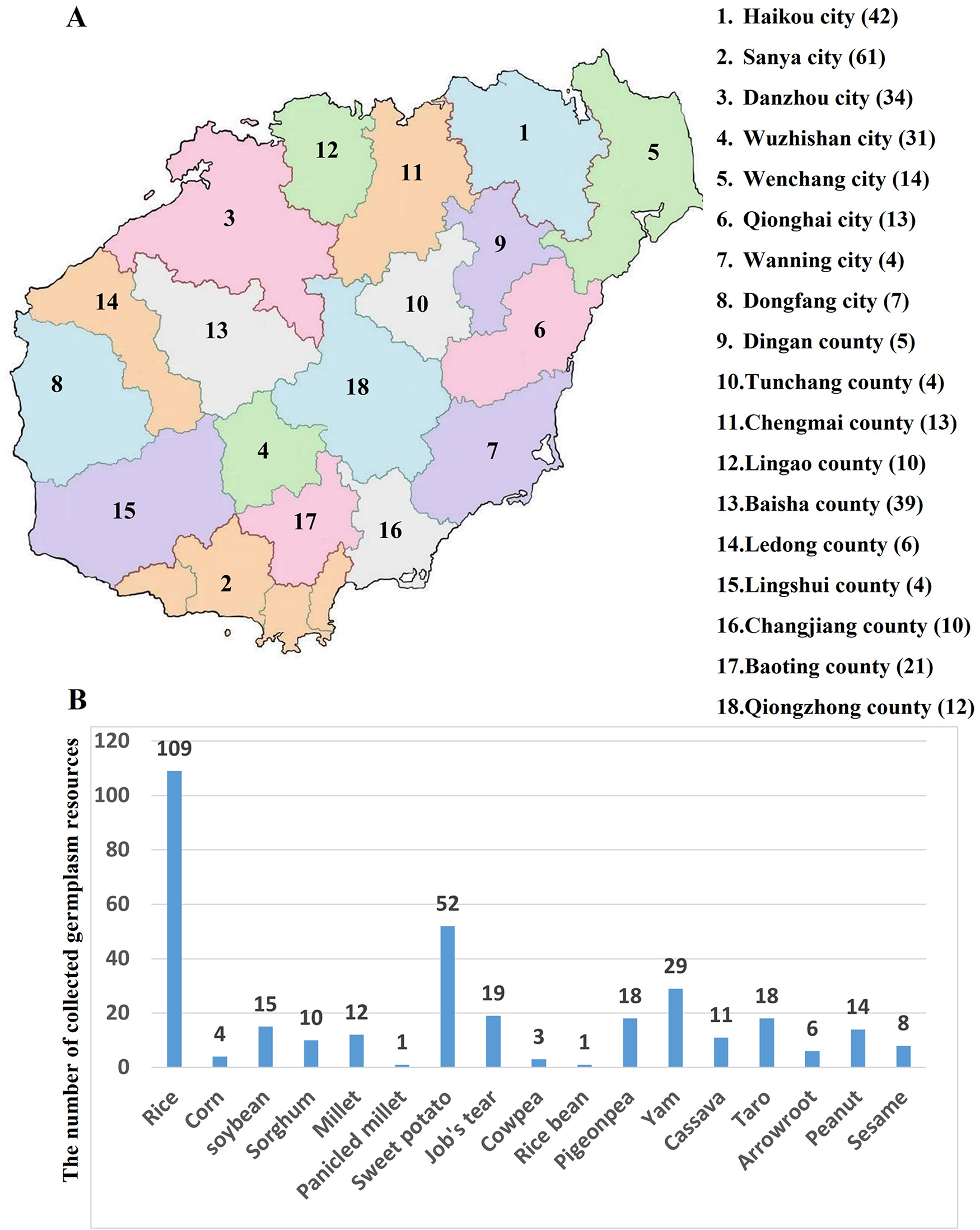
Figure 1. The collected food crop germplasm resources in Hainan. (A) The geographic distribution of the collected food crop germplasm resources and (B) the number of collected food crop germplasm resources. In (A), the numbers on the left-side map correspond to the order of cities on the right, while the numbers in parentheses on the right indicate the number of collected germplasm resources. The map of Hainan Island is a modified version based on the map issued by the Ministry of Natural Resources of China, available at (http://bzdt.Ch.Mnr.Gov.Cn/browse.Html?picid=%224o28b0625501ad13015501ad2bfc0185%22).
During the survey, a crop germplasm resource collection form was completed, recording detailed information such as the sample number, collection date and location (including GPS coordinates, latitude, longitude and altitude), germplasm (variety) name, category, origin and habitat, characteristics and traits of the germplasm resources, their uses, local sowing and harvesting times, cultivation area and duration, as well as information about the collector and the sample provider. Additionally, historical and cultural information related to the germplasm resources was documented, and photographs of the samples were taken for reference and preservation (Shi et al. Reference Shi, Chen, Li, Li, Yang, Shi, Liu and Wu2018; Tang et al. Reference Tang, Yan, Yang, Zhong and Tang2018).
After assessing resource abundance and habitat conditions, a radial sampling method was used within a 1 km radius centred on each sampling site. Once a target sample was identified, relevant information was immediately recorded and seeds were collected. To ensure genetic diversity, at least 50 individual plants were selected from different areas of the field and a panicle was collected from each plant and stored separately. The collected seeds were dried in a ventilated and shaded environment for approximately 7–10 days to reduce moisture content and prevent mould or deterioration. After drying, the seeds were packaged in aluminium foil bags. Each sample was carefully labelled, sealed and the associated information meticulously recorded to ensure sample accuracy and to prevent mixing (Lu et al. Reference Lu, Chen and Liu2008; Yao et al. Reference Yao, Wu, Zhang, Dai, Yang, Huang, Liu and Fang2021). From all the collected germplasm resources, a subset of samples for each sexually reproducing species was selected and sent to the cold store of the Hainan Academy of Agricultural Sciences for preservation. The number of samples preserved was determined according to the relevant standards of the Hainan Academy of Agricultural Sciences (Table S1). All resources were subjected to both short-term (4°C for 6 months) and medium-term (0°C for 3 years) cold storage. During storage, seed germination rates were monitored after 6 months and 3 years, respectively, to assess preservation effectiveness and sample viability (Lu et al. Reference Lu, Chen and Liu2008).
Results
The novelty of the collected resources in this survey
A total of 1180 materials were collected during this survey, encompassing 7 families and 237 species (Table 1). None of these materials are recorded in the China National Repository. This suggests that this collection of germplasm resources is both diversity and unique. Of the germplasm collected, the Poaceae family was the most abundant, contributing 207 samples (17.54% of the total) across six genera, including Oryza, Coix, Setaria and Zea (Table 2). The Cucurbitaceae family, primarily melons, constituted the least of the germplasm with only 74 resources. The ‘Other’ category encompassed a wide variety of germplasm, including fruit crops such as areca nut (Areca catechu), guava (Psidium guajava) and passion fruit (Passiflora edulis); The vegetable crops included taro (Colocasia esculenta), eggplant (Solanum melongena) and Chinese yam (Dioscorea polystachya). The economic crops were sesame (Sesamum indicum), camellia (Camellia) and large-leaf tea (Camellia sinensis var. assamica) are also included.
Table 1. Summary of collected germplasm resources

Table 2. Different characteristics of collected food crop germplasm resources in Hainan
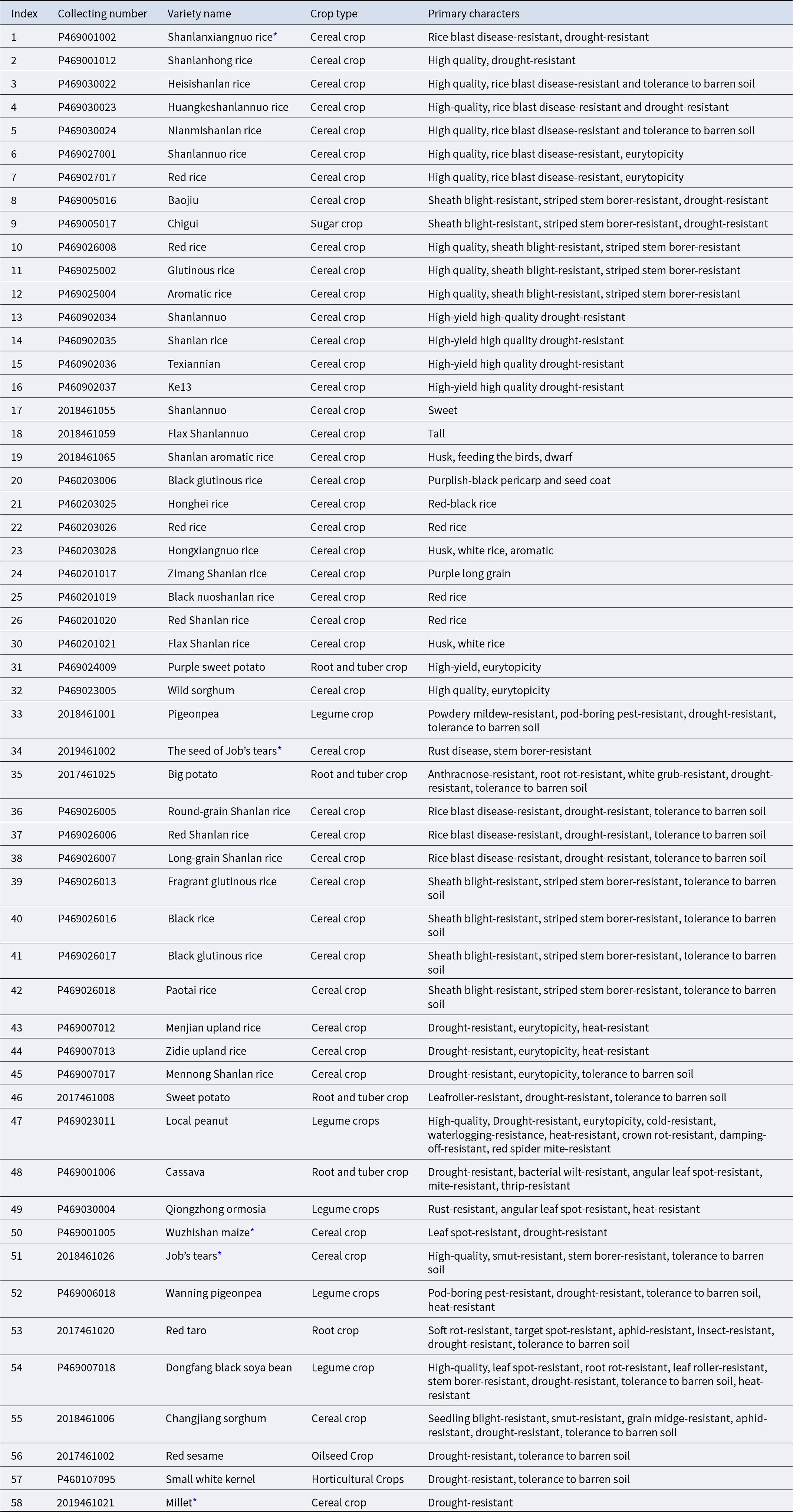
* Note: The asterisk (*) in the table to indicate rare and endangered varieties.
Investigation and collection of germplasm resources of food crops in Hainan Island
Of the 1180 germplasm resources, 330 were food crop germplasm resources, including 17 types of food crops, such as local rice, corn and soybean (Fig. 1B). The germplasm resources were found in farmlands and open spaces in front of and behind houses, with altitudes ranging from 2.73 to 657.12 m across 18 cities in Hainan Island (Fig. 1A).
According to experienced local farmers, many of the collected germplasm resources were characterized by stress resistance traits, including disease resistance, pest resistance and drought tolerance (Table 2). Among these materials, 28, 20, 27, 20 and 17 varieties showed disease resistance, pest resistance, drought tolerance, tolerance to poor soil conditions and high-quality traits, respectively. In addition, 11 varieties demonstrated health-promoting properties and unique applications, with 1 variety notably enriched in selenium and multiple vitamins (Table 3).
Table 3. Landrace with special purpose in Hainan
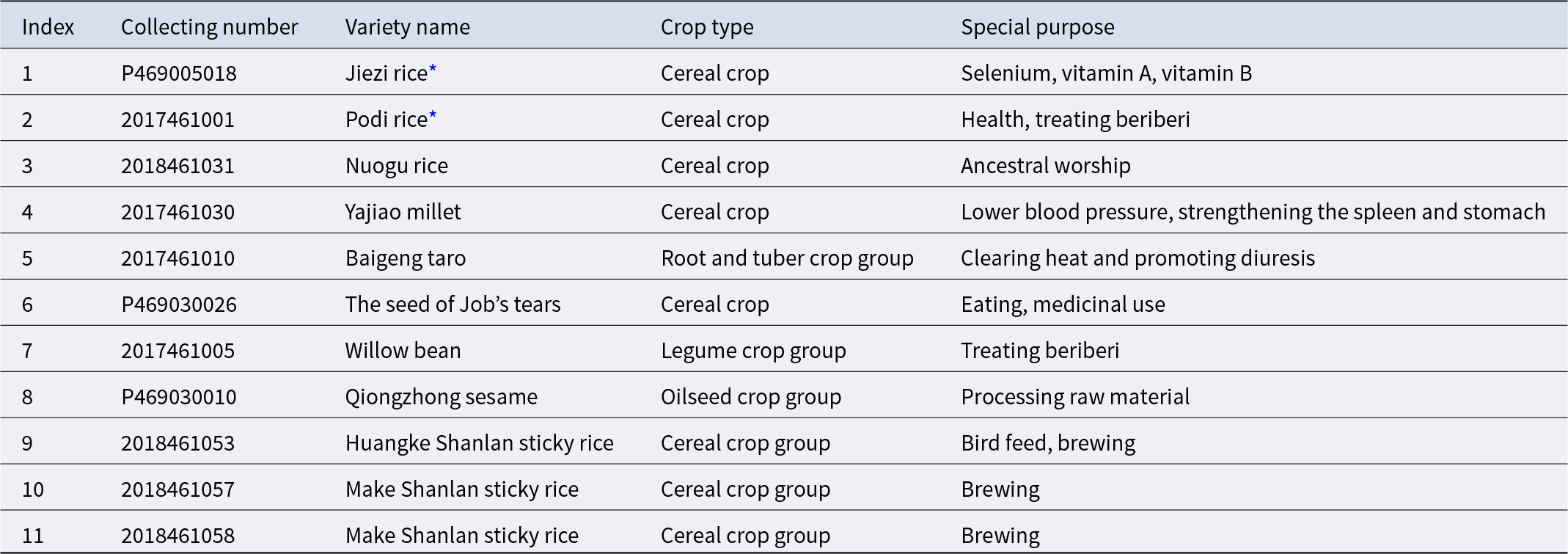
* Note: The asterisk (*) in the table to indicate rare and endangered varieties.
The changes of Hainan agriculture industrial structure
Hainan Province conducted crop germplasm resource surveys in 1951 and 1981. A comparison with the latest survey in 2014 revealed significant changes in crop planting structure: the food crop area steadily declined, while the areas for vegetables, fruit trees and economic crops progressively increased (Fig. 2). In 1956, food crops covered 90.16% of the province’s total cultivated area. This share dropped to 81.54% by 1981 and further declined to 47.74% in 2014, marking a cumulative reduction of 42.42% over 68 years. Meanwhile, the share of vegetables, fruit trees and economic crops in the cultivated area increased markedly. Fruit trees grew the most (+17.10%), followed by vegetables (+16.10%) and economic crops (+8.69%). From 1956 to 2014, Hainan’s crop planting structure underwent notable shifts. In 1956, major crops consisted of food crops, economic crops and vegetables. By 1981, fruit trees replaced vegetables as a primary crop. By 2014, the structure prioritized food crops, vegetables and fruit trees. These changes illustrate Hainan’s transition from a single-crop reliance to a diversified agricultural model, emphasizing the growing importance of non-food crops in the crop structure.
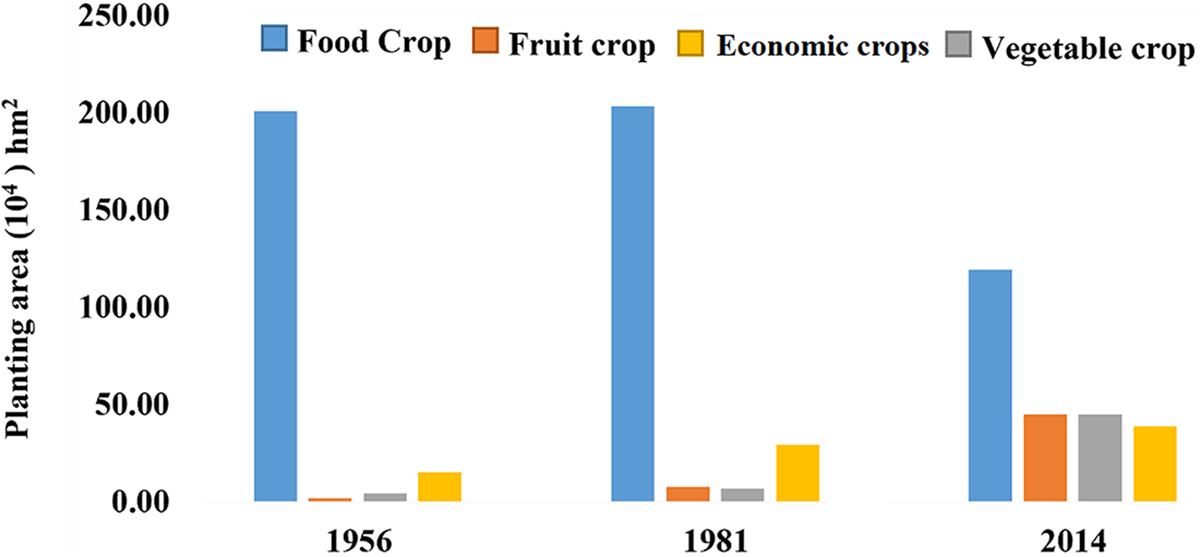
Figure 2. Planting areas of different crop types in the three survey years.
Discussion
The local rice variety resources in Hainan have a long history of cultivation
Rice is the primary staple crop in Hainan. Rice cultivation in Hainan has a history of over 2000 years, originating when ancient inhabitants began planting rice for sustenance and other uses. Early rice cultivation in Hainan was concentrated near rivers and coastal areas, where fertile soil and abundant water resources supported rice growth. Historical records show that large-scale rice cultivation on Hainan Island began during the Eastern Han Dynasty (AD 214). During this period, war and political unrest prompted many people from the Central Plains to migrate to Hainan, bringing advanced agricultural techniques and experience. As the population grew and agricultural technology advanced, rice cultivation in Hainan expanded into mountainous and hilly areas. Resource surveys reveal that local rice varieties are highly adaptable and can be cultivated in most areas of Hainan. Surveys also indicate that the central mountainous region contains the richest diversity of local rice cultivars. This is attributed to both suitable natural conditions and the long history of mountain-based food crop cultivation, which plays a significant role in local agriculture and provides substantial benefits.
Local food crop varieties in Hainan are primarily used for cooking rice, making porridge and preparing rice rot. One collected variety, ‘Jiezi rice’ from Wenchang City (P469005018), is rich in selenium as well as vitamins A and B. Local enterprises have developed and marketed this rice at 35 yuan per kilogram, a price significantly higher than regular and other rice varieties, contributing to rural revitalization. Uncovering outstanding local crop varieties such as ‘Jiezi rice’ is also one of the key objectives of this survey.
The relationship between the collected germplasm resources and Hainan ethnic traditional culture, agricultural civilization and geographic environment
Hainan Island, with its unique geographic environment and rich ethnic diversity, has long been a cradle of diverse germplasm resources. These resources are not merely biological assets; they are deeply intertwined with the island’s traditional culture, agricultural civilization and natural landscapes, reflecting a harmonious coexistence between humans and nature.
The collected germplasm resources include various crops, such as upland rice, particularly the traditional Shanlan rice, which holds significant cultural and agricultural importance for ethnic groups like the Li people. Over centuries of cultivation, these crops have adapted to the island’s tropical climate and diverse terrain. The Li people, renowned for their sophisticated farming methods, have developed complex systems to manage these resources, ensuring their sustainability and adaptability. For instance, Shanlan rice, a drought-tolerant variety primarily grown in mountainous areas, exemplifies the Li people’s deep understanding of and adaptation to the local environment. Cultivating these crops is not merely an economic activity but also a cultural practice, deeply embedded in community rituals and festivals. One prominent example is the ‘March 3rd’ Festival, the most significant traditional folk celebration for the Li and Miao ethnic groups, as well as a romantic occasion for young people. Every year, on the third day of the third lunar month, Li people don festive attire and bring Shanlan rice and Shanlan rice wine to gather from all directions. The celebrations begin with ancestral worship, followed by singing in groups, dancing and playing musical instruments to mark the joyous season. Shanlan rice is not only a staple food for the Li people but also a crucial offering and dish during this festival. Additionally, Shanlan rice wine, a symbol of harvest and joy, plays a vital role in expressing respect for ancestors and love for life, making it an indispensable part of the festivities.
Beyond its cultural significance, germplasm resources are closely linked to Hainan’s agricultural civilization. Traditional farming techniques, passed down through generations, such as intercropping and crop rotation, aim to enhance yields while maintaining soil fertility. These practices serve as a testament to the island’s rich agricultural heritage. Thus, the collected resources are not just samples of biodiversity; they are living records of agricultural wisdom accumulated over centuries. Hainan’s geographic environment has played a critical role in shaping these germplasm resources. The island’s diverse landscapes, ranging from coastal plains to volcanic mountains, provide a wide array of ecological niches for various crops. This diversity, in turn, supports a wealth of traditional cultures, each with its unique agricultural practices and food systems. As a result, the collected germplasm resources reflect the intricate relationship between the land and its inhabitants. The germplasm resources collected in Hainan are integral to the island’s cultural and agricultural identity. They represent the profound connections between ethnic communities, their traditional practices and the natural environment. As efforts to conserve and utilize these resources continue, it is essential to recognize and respect this intricate relationship to ensure that Hainan’s agricultural heritage is preserved for future generations.
Existing challenges and suggestions in Hainan crop germplasm resource conservation
The existing challenges can be categorized into the following three aspects:
1. Decline of local varieties and challenges in resource collection. Local food crops are mainly derived from seeds saved by farmers, who often lack scientific knowledge of seed preservation. Prolonged cultivation results in significant variety degeneration, including reduced resistance, quality and yield, which leads to the gradual elimination and a risk of extinction. Furthermore, macro-level agricultural policies prioritize advantageous industries while abandoning less competitive ones, promoting monoculture and causing some local varieties to develop in a single direction. Valuable local varieties are increasingly excluded from markets and gradually vanish from production. Meanwhile, rapid advancements in agricultural science and technology have led to the development and promotion of new, superior varieties. In pursuit of maximum economic benefits, farmers have replaced older varieties that no longer meet modern agricultural demands, accelerating the loss of old germplasm resources (Zheng and Yang Reference Zheng and Yang2014; Liu et al. Reference Liu, Deng, Li, Yang, Yang, Wang and Yu2017).
2. Confusion in variety identification due to local naming practices. Hainan, as a major introduction site for food crop resources, hosts numerous local varieties. This has led to a chaotic situation where the same name may refer to different varieties, or the same variety may have multiple names.
This naming confusion results in mixed planting of different varieties, reduced variety purity and the loss of desirable traits, ultimately leading to the decline of local varieties. Additionally, it increases the complexity of germplasm resource collection, identification and preservation (Tang et al. Reference Tang, Yan, Yang, Zhong and Tang2018). To address this, phenotypic identification of newly collected resources is essential. When funding permits, SSR fingerprinting technology should be employed for accurate identification (Liu et al. Reference Liu Z, Lin Z, Li H, Xu Y, Li G, Qiu Y, Qiu S and Tang2018). Combining phenotypic verification with molecular biology enables the analysis of differentiation, origins and evolutionary patterns of local resources.
3. Limitations in the food crop germplasm resource preservation system in Hainan Province. Currently, Hainan Province has only one germplasm resource repository, the ‘National Tropical Crop Medium-Term Bank’, which primarily stores tropical crop resources. The Hainan Academy of Agricultural Sciences has independently funded the construction of a crop cold storage facility. However, due to prolonged construction time and insufficient funding, the facility’s equipment and infrastructure remain inadequate. Compared with advanced domestic germplasm repositories, there is a significant gap, limiting the preservation capacity of crop germplasm resources.
It is recommended to prioritize the major needs of agricultural innovation and modern seed industry development. Efforts should focus on comprehensive collection, proper preservation, detailed evaluation, active innovation and shared utilization of germplasm resources. Medium- and long-term storage facilities should be constructed, and germplasm repositories (gardens) should be improved. Additionally, wild, high-quality and rare crop germplasm resources in Hainan and surrounding areas should be systematically collected and preserved. Establishing a complete germplasm resource protection system is critical to ensuring long-term preservation and utilization of crop germplasm resources.
Additionally, in situ conservation is a critical component of a comprehensive conservation strategy, complementing ex situ conservation to ensure the complete protection of germplasm resources. In situ conservation involves preserving crop varieties in their natural habitats, such as traditional farming systems or natural ecosystems. This method allows the resources to continue evolving under local environmental conditions, maintaining their adaptability and resilience. For example, in Hainan, traditional crops like Shanlan rice are cultivated by the Li people in mountainous areas. These practices not only preserve the genetic diversity of the crops but also sustain the cultural and agricultural heritage of the local communities. Additionally, in situ conservation supports the dynamic interaction between crops and their environment, which is essential for long-term sustainability. While ex situ conservation (e.g. seed banks and germplasm repositories) provides a secure backup for germplasm resources, it cannot fully capture the ecological and cultural context in which these resources thrive. In situ conservation complements this by preserving the living relationship between crops, their environment and the traditional knowledge associated with their cultivation. Together, these approaches ensure a more holistic and robust conservation strategy.
4. A comprehensive and systematic characterization of food crop germplasm resources is essential. Currently, germplasm resource characteristics are primarily obtained through discussions with experienced local farmers, relying on their long-term cultivation practices. However, no in-depth investigation of these characteristics has yet been conducted. Future works will focus on detailed trait investigations and comprehensive documentation of the collected food crop germplasm resources. This will involve systematically recording phenotypic characteristics, including growth habits, pest and disease resistance, yield potential and quality traits. Such investigations will facilitate precise identification and evaluation of germplasm, ensuring valuable traits are preserved. Modern molecular biology techniques, including genome sequencing and SSR fingerprinting, will complement phenotypic data, offering deeper insights into the genetic basis of key traits.
Efforts will also focus on establishing a standardized database integrating phenotypic, genotypic and ecological data for all collected resources. This database will underpin future breeding programs, allowing researchers to efficiently select and utilize germplasm with desirable traits to develop improved crop varieties. These efforts will not only strengthen the germplasm resource preservation system but also promote the sustainable development of agriculture and the seed industry in Hainan Island.
Conclusion
From 2017 to 2021, the Hainan investigation team systematically surveyed and collected germplasm resources of food crops in Hainan Province, yielding significant findings that enhance the conservation and utilization of agricultural biodiversity in the region. The study documented the distribution of food crop germplasm resources across districts and identified key traits, including superior quality and tolerance to drought and poor soil conditions. The collection of 330 food crop germplasm resources, including rare and endangered varieties, has expanded the genetic pool for future breeding programmes and established a strong foundation for developing new crop varieties.
Supplementary material
The supplementary material for this article can be found at https://doi.org/10.1017/S1479262125100063
Author contributions
Q.T. conceived and designed this research. L.Z. and X.Y. undertook material collection and phenotypic identification. G.C. wrote the original draft. G.C., J.X., H.Z., L.T., L.L. and Q.W. contributed to materials collection, preservation and classification. All authors have read and agreed to the published version of the manuscript.
Funding statement
This work was supported by the Hainan Province Science and Technology Special Fund (ZDYF2024KJTPY027), the Department of Agriculture Species and Variety Resources Protection Fund Project (111821301354052033), China Key R&D Program Project (2021YFD1200102-01). The Technical Innovation Professional Project of the Provincial Scientific Research Institutes in Hainan Province (jscx202003), Key R&D projects in Hainan Province (ZDYF2024XDNY165) and Coordinated scientific research projects of HAAS(2024-LZSQN005).
Competing interests
The authors declare that the research was conducted in the absence of any commercial or financial relationships that could be construed as potential conflicts of interest.

